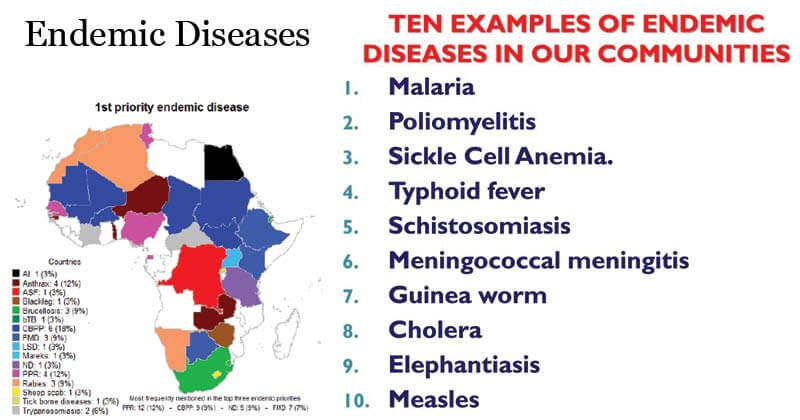- Communicable diseases are termed endemic when they have a relatively stable pattern of occurrence in a given geographical area or population group at the relatively high prevalence and incidence.
- It refers to the constant presence of a disease or infectious agent within a given geographic area or population group, without importation from outside.
- It may also refer to the “usual” or expected frequency of the disease within such area or population group.
- For instance, the common cold is endemic because somebody always has one.
- An endemic disease when conditions are favorable may burst into an epidemic (e.g., hepatitis A, typhoid fever). If conditions change in the host, the agent or the environment, an endemic disease does so.
- For example, improved smallpox control in Europe was reversed during the First World War.
- As new control or preventive measures are applied, the endemic status of the disease may change.
- Endemic diseases such as malaria are among the major health problems in low-income tropical countries.
- The HIV epidemic is an example of an infectious disease that has become endemic in many areas, while in other areas it still causes epidemics in previously unexposed populations.

Image Source: Theodore J D Knight-Jones
Interesting Science Videos
Epidemics Vs Endemics
- Epidemic disease is the sudden outbreak of the disease in a particular area.
- Endemic is the persistence of a particular disease within a geographical region.
- Endemic diseases are relatively rare and not as widespread as an epidemic.
- It is always prevalent in the population that lives in that area.
Hyperendemic Disease and Hypoendemic Disease
- The term “hyperendemic” expresses that the disease is constantly present at a high incidence and/or prevalence rate and affects all age groups equally.
- The term “holoendemic” a high level of infection beginning early in life and affecting most of the child population, leading to a state of equilibrium such that the adult population shows evidence of the disease much less commonly than do the children, as in the case of malaria.
Examples of Endemic Diseases
- Chagas Disease
About 7.6 million people are infected with Chagas disease. It is caused by a protozoan parasite, Trypanosoma cruzi. This disease is endemic to Mexico, South, and Central America. Chagas disease is divided into acute phase, asymptomatic intermediate phase, and the chronic phase.
- Malaria
Malaria is an endemic disease prevalent in Africa, Asia, Latin America, and the Middle East. It is transmitted by a protozoan parasite from the Plasmodium genus. They destroy the red blood cells in the spleen and liver. This causes anemia in the patients and can prove fatal if left untreated. According to recent research, 200 to 500 million people suffer from malaria every year out of which 1.5 to 2.7 million do not survive.
- African Sleeping Sickness
This disease is caused by a protozoan parasite belonging to two different species of the Trypanosoma genus. This disease is prevalent in Sub-Saharan Africa. It causes fever, joint pain, sweating, and headaches. Slowly the parasite invades the central nervous system and causes a disturbance in the sleep cycle, poor coordination, and confusion. Endemic diseases are often confused with epidemic diseases. An epidemic is an outbreak of a disease, however, the endemic disease is the one that is constantly prevalent in a particular geographical area.
Control of Endemic Diseases
There are various types of methods to control these diseases.
- The major agent that is involved in the spread of the disease is traced and the keen control over the agent is always maintained.
- Educating the people in the locality regarding the ways to control the disease and about the modes of methods involved in spreading the disease.
- Providing proper sanitary methods in all areas which will help to prevent and control the spread of the disease.
References
- Park, K. (n.d.). Park’s textbook of preventive and social medicine.
- Beaglehole, Robert, Bonita, Ruth, Kjellström, Tord & World Health Organization. (1993). Basic epidemiology, Updated reprint. World Health Organization.
- Gordis, L. (2014). Epidemiology (Fifth edition.). Philadelphia, PA: Elsevier Saunders.
- https://www.ncbi.nlm.nih.gov/mesh?term=Endemic+Diseases
- https://byjus.com/biology/endemic-diseases/
- https://www.verywellhealth.com/what-is-an-endemic-disease-3132825
- https://www.who.int/mediacentre/commentaries/2016/Endemic-infectious-diseases-next-15-years/en/
- https://www.sciencedirect.com/topics/medicine-and-dentistry/endemic-disease
- https://www.omicsonline.org/control-of-endemic-diseases-scholarly-open-access-journals.php
- https://www.who.int/water_sanitation_health/dwq/iwachap4.pdf?ua=1
- https://www.britannica.com/science/endemic-disease
